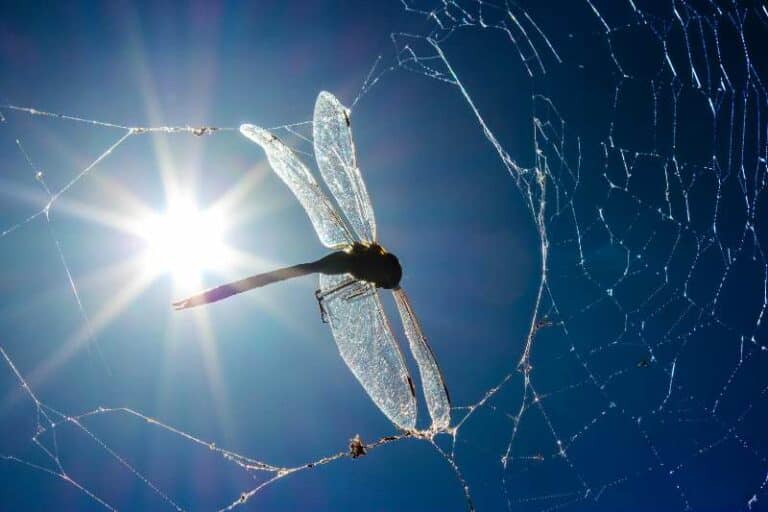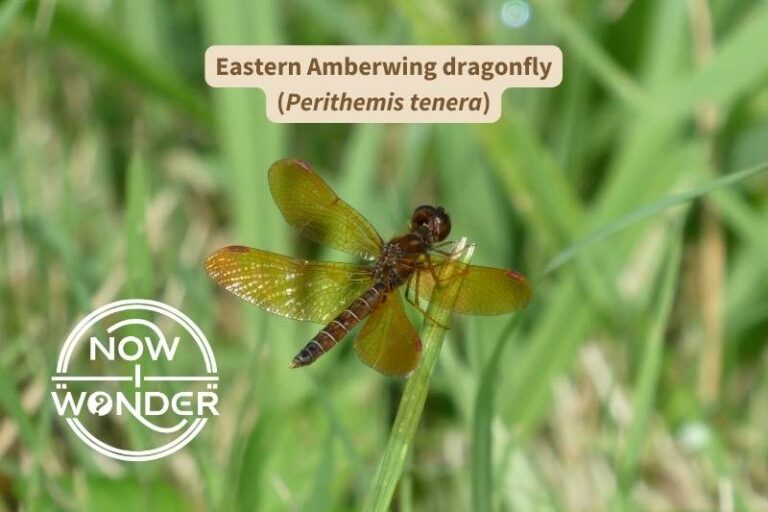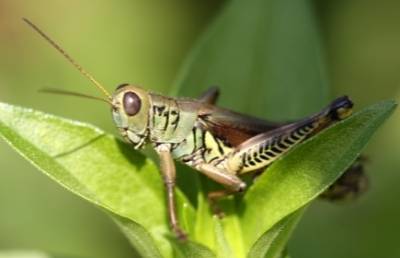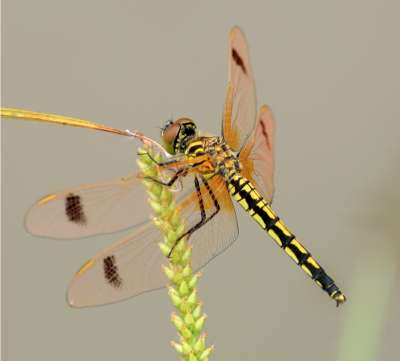Reptiles cannot chew their food before swallowing because they lack the anatomical structures which allow chewing. Chewing requires specialized teeth, tongues, and jaw and mouth muscles and aids digestion. Reptiles do not need to chew their food to digest it so did not evolve the ability to do so.
The act of chewing is more complicated than simply moving one’s jaws. Merriam-Webster dictionary defines the verb “to chew” as “to crush or grind with teeth”, the verb “to crush” as “to squeeze out of shape; to grind or pound to small bits”, and the verb “to grind” as “to reduce to small particles” (Merriam-Webster 2004).
In order to meet the criteria of being able to chew, an animal must squeeze food out of shape and break it into small pieces using their teeth.
Why don’t snakes, turtles, lizards, and alligators meet this criteria? Let’s first look at the specialized anatomy an animal has to have to chew.
What anatomy is required for chewing?
| Strongly connected, rigid upper and lower jaw bones | Required to transmit enough force to crush, grind, or pound food into smaller pieces. |
| Muscles that move jaw(s) from side to side | Required to reposition the teeth to crush, grind, or pound food that has not yet been chewed. |
| Strong tongues that move side-to-side and precisely | Required to reposition food between teeth to be crushed, ground, or pounded. |
| Flat, broad tooth surfaces | Required to balance the food between teeth while being chewed and to provide a hard, pressure-resistant surface against which food can be crushed, ground, or pounded. |
| Cheeks | Required to enclose the sides of the mouth to keep food from falling out while jaws are working. |
| Lips | Required to enclose the front of the mouth to keep food from falling out while jaws are working. |
Why can’t snakes chew?
Snakes cannot chew because their jaws are too flexible to transmit the bite force needed to crush food, their sharp fangs offer no hard, flat surface suitable for grinding, their slim tongues find prey rather than manipulate food, and they have no cheeks or lips to hold food in the mouth.
Snake jaw bones are flexible, mobile, and only loosely attached to their skulls. The upper jaw of most snakes consists of six bones while the lower jaw consists of two. All these pieces are connected by elastic ligaments that can stretch significantly. This mobility allows snakes to gape their mouths wide, engulf prey that is much larger than their heads, and move the prey towards the back of the mouth for swallowing.
Snakes can move their multi-jointed jaws from side to side but they do this to further advance their jaws around the prey they are swallowing rather than reposition the food in preparation for crushing or grinding.
Unlike the thick, muscular tongues found in animals that chew, snakes have long, slim, flexible tongues.
Snakes sense their environment by flicking their forked tongues out the front of their mouth, then tasting the molecules in the air using a special organ called the Jacobson organ in the roofs of their mouths.
While their tongues are flexible enough to move side to side to reposition food, the muscles are small and relatively weak. Snakes don’t use their tongues to press food into position for either chewing or swallowing; they are primarily sense organs.
All snakes are carnivores so evolved teeth specialized for attacking and killing live prey. Snake teeth are anything but flat and broad; they offer no platform upon which to position food and press against as is required for crushing and grinding food.
Most snakes have six rows of teeth; four upper and two lower (Doneley 2018) which are always angled backwards to point towards the snakes’ throats and are replaced throughout the snakes’ lives (Aspinall and Capello 2020).
Snake fangs are extremely sharp and fixed in place with the exception of the elongated front fangs of the Viperidae snakes which fold into depressions in the roofs of their mouths when not used to inject venom.
All snakes swallow their prey whole and usually head first; their teeth are unsuited for ripping or slicing away chunks of flesh. Prey attacked by vipers are usually dead or at least paralyzed by the injected venom but prey attacked by non-venomous snakes can often still fight back even once bitten.
The backwards curve of snake fangs grip the prey animal and prevent it from escaping the snake’s mouth or fighting back effectively. Snake teeth are superb for these purposes but completely unsuited for chewing.
Finally, snakes do not have fleshy cheeks or lips to keep food contained in the mouth even if the snake could chew it into smaller and smaller pieces.
Snake mouths and faces are hard and covered in horny scales. The skin that underlies individual scales on a snake’s head and face stretch easily along with the jaw bones to engulf prey but doesn’t manipulate food once in the snake’s mouth or help with swallowing. Snakes use their teeth and mobile jaw sections to reposition their prey for being swallowed whole.
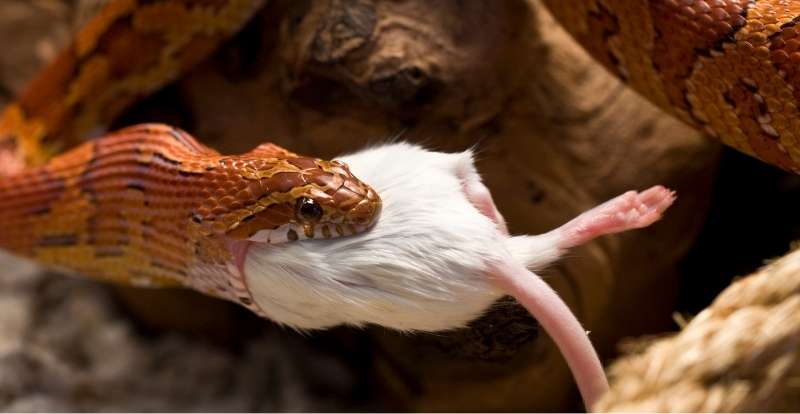
Why can’t turtles chew?
Turtles cannot chew because they have rigid jaws that only open and close vertically on a single plane and cannot be re-positioned to crush food, they have sharp, horny beaks that cannot close around food while the jaws are moving, and have no teeth against which to crush and grind food.
Unlike snakes, turtle jaws are not flexible or very mobile. Both upper and lower jaws are single bones; they are strongly connected at the hinge by stiff ligaments that do not stretch significantly.
The gape of a turtle’s mouth is much more restricted than those of snakes; while the muscles that open and close their mouths are strong, the bony structures of their jaws limit how wide they can open their mouths and thus the size of the mouthful that will fit per bite.
Turtle jaws move up and down in a single plane only. Since they can’t move their jaws from side to side, turtles can’t work wide pieces of food into their mouths the way animals whose jaws can move laterally can.
Turtles also can’t crush or grind food by repositioning their jaws; the upper and lower jaws come together in the exact same spot with every bite. Therefore, turtles excel in slicing chunks of food into smaller pieces but they must either drop large bites entirely and pick them up again or reposition the food with their tongues before they can bite the same chunk of food in a different spot.
Here is video by ASMR Animal YouTube channel of a turtle eating several different kinds of food:
Turtle tongues are thick and fleshy but not as mobile as tongues in animals that chew. They can’t protrude from their mouths (Aspinall and Capello 2020) and are limited in side to side movement. Turtles use their tongues to push food off their jaws when stuck and to work chunks of food towards the throat for swallowing but not for repositioning food between the jaws for chewing.
Turtles don’t have any teeth at all; they have hard, sharp beaks that slice into their food. These reptiles never evolved teeth because they never needed them.
Approximately one quarter of turtles species are herbivores and eat only plants. The remaining three quarters of species are omnivores and eat both plants and animals (Doneley 2018). Depending on the species, prey animals consist of soft organisms like earthworms, larval insects, and slugs or harder creatures like adult insects and molluscs.
If a food item is small enough, turtles swallow it whole. If it is too large to fit into their mouths, turtles use their strong jaws and sharp beaks to slice chunks off, which are then also swallowed whole. Some turtles have sharp bony teeth in the roofs of their mouths to help them crush mollusk shells or prevent slippery prey from escaping but no turtle has the kind of broad, flat teeth that support chewing. Their beaks are sufficiently strong to feed on all these food sources even without teeth.
Turtles also don’t have lips or cheeks. Their mouths are hard and the jaws end in the sharp, horny beaks discussed above. The base of the upper and lower jaws are connected by a thin, flexible membrane but this is different from the muscular cheek structures that support chewing in other animals. The membrane stretches so the jaws can gape as wide as the joint allows but lacks muscles to control the position of the turtle’s food.
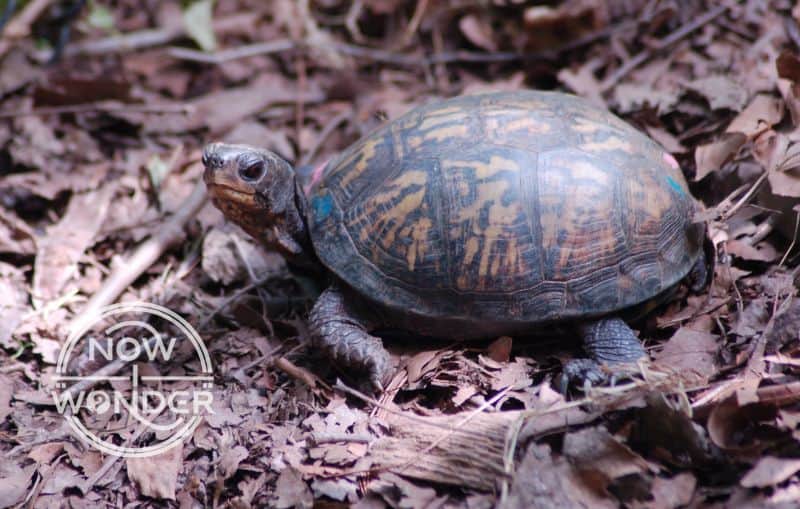
Why can’t alligators chew?
Alligators cannot chew because they have rigid jaws that only open and close vertically on a single plane and cannot be re-positioned to crush food, they have no lips or cheeks to close around food while the jaws are moving, and their peg-like teeth are designed to grip, not to crush or grind.
Alligator jaws are very long, made of solid bone, and very strongly connected at the hinge joint. Their mouths can gape extremely wide and generate a lot of power.
However, the stiff ligaments at the hinge joint restrict the jaws’ movement and and the muscles that power alligator jaws are strictly arranged for up and down movement only. Alligators can’t move their jaws from side to side so are unable to reposition food for chewing – alligators can snap their jaws open and closed in one direction.
The advantage for alligators of such an arrangement is that the rigid jaw bones transmit the huge bite forces generated by their powerful jaw muscles straight into their prey. This makes it almost impossible for a hapless fish, bird, or deer that ventures too close to a lurking alligator to escape once the reptile bites down.
Alligator tongues are broad, thick, and strong but have limited movement. Like turtles, their tongues can’t protrude from their mouths and are used to help the reptile swallow chunks of food, not to chew.
Alligators are ambush predators that live in fresh and brackish water and eat a wide variety of animals. They lie in wait under the water’s surface for prey to approach, then erupt out of the water and snap their jaws around the prey.
Small prey like birds are killed by the alligator’s bite directly. Larger prey like deer are pulled under the water and drowned; they can’t escape the combination of the powerful bite and the sharp teeth.
Alligator teeth are specialized for gripping prey and not for chewing or even slicing away chunks of flesh. They are sharp, thick pegs arranged around the edge of both the upper and lower jaws, and alligators have a lot of them.
Small prey that can fit through the opening formed by the jaw hinge is swallowed whole. Large prey is usually stashed in a “larder”, held underwater by reeds or riverbank overhangs. The alligator leaves the carcass to soften and rot underwater then returns to feed. It bites down on the anchored carcass and spins underwater. This twists chunks off the prey that are small enough for the alligator to swallow whole – no chewing required.
Like their reptile relatives, alligators do not have cheeks or lips. Alligator mouths are hard and immobile and their jaws are connected by a stretchy but thin membrane that allows for gape but lacks muscles.
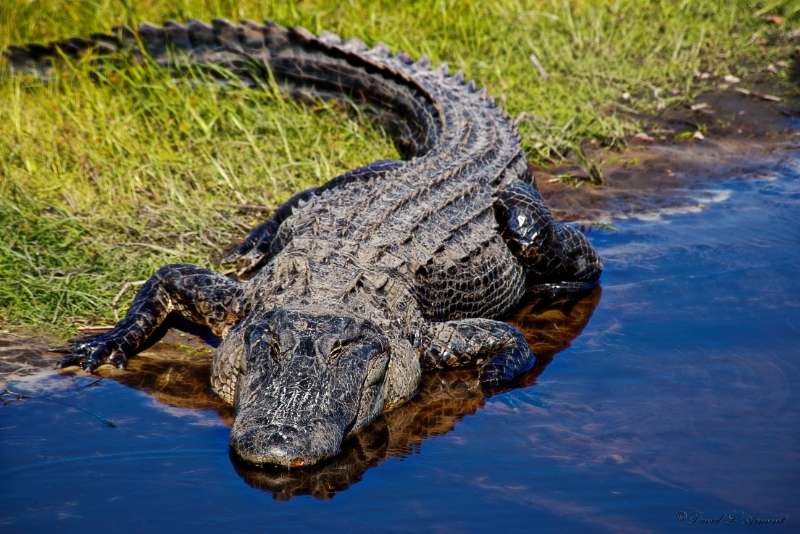
Why can’t lizards chew?
Lizards cannot chew because their jaws lack the side-to-side mobility that allows continual repositioning of food, they have no cheeks or lips to prevent food from falling out of the mouth while the jaws are working, and their teeth are designed to grip and pierce rather than crush and grind.
Lizards are usually insectivorous or omnivorous and eat a wide variety of food. Non-insect foods can include slugs and snails, spiders, millipedes, earthworms, bird eggs, and, depending on the size and species, nestling mammals and birds. Only 3% of lizards are exclusively herbivorous like the green iguana (Iguana iguana) (Doneley 2018).
Lizard skulls are a combination of the flexibility and rigidity seen in other reptiles. Like snakes, the bones of lizard skulls are loosely connected to each other so are slightly flexible. But unlike snakes, their lower jaws are firmly connected at the snout and function as single bones. Like other reptiles with the exception of snakes, lizard jaw bones are strongly connected to each other at the jaw hinge and do not move from side to side.
Here is short video by National Geographic Wild YouTube channel showing a Green Anole (Anolis carolinensis) eating a grasshopper:
Lizards lack lips and cheeks but do have mobile, extendable tongues which are anchored at the back and bottom of their mouths. Many species have Jacobson’s organs in the roofs of their mouths so flick their tongues out to sample molecules from the air (Halliday and Adler 1986).
Lizards use their tongues more to sense important information about their surroundings, like the presence of prey, than for repositioning food when eating.
Most lizards have tiny teeth shaped like cones which are positioned in different parts of the mouth, depending on the type of lizard.
Species like iguanas are “pleurodonts”. Pleurodonts have teeth which are attached to the insides of their jaws and are only weakly attached so are shed and replaced periodically.
Other lizards, such as chameleons, are “acrodonts”. Acrodonts have teeth which are firmly attached to the edges of the jaws and aren’t shed (Aspinall and Capello 2020).
But chewing required grinding or crushing food against tooth surfaces to break it into smaller pieces; neither pleurodont nor acrodont teeth are suitable for this.
Lizards can only swallow small pieces of food, usually chunks that are about half the width of their heads. They must target small prey which can be swallowed whole, tear chunks off larger food items with their teeth or position prey carefully.
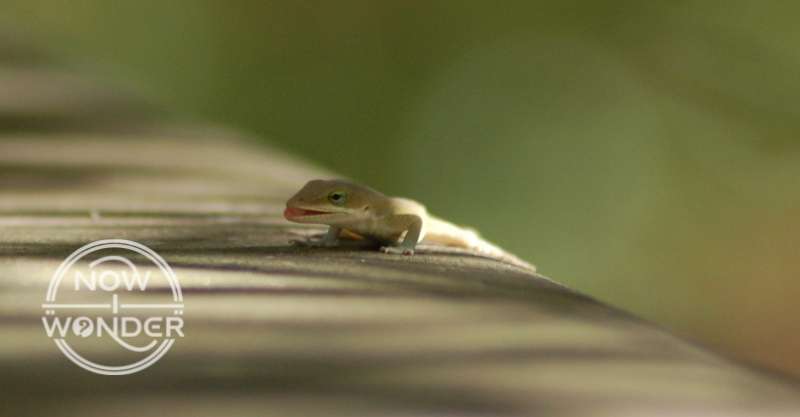
Some reptiles make motions while eating that mimic chewing – meaning their jaws work up and down rhythmically while food is in their mouths. However, this behavior doesn’t mean that they are chewing their food based on the definition included at the beginning of this post.
Venomous snakes may appear to chew their food as they work their fangs deeper into their prey to increase the venom load and kill the animal faster.
Many snakes “walk feed”, which is when snakes engulf their prey by moving sections of their jaws forward in sequence. One section advances further along the prey’s body, anchors itself with the embedded teeth, then a different section advances. The rhythmical movement makes it appear as though the snake is chewing its food but really, it is simply moving the prey closer to the throat, where it can be swallowed whole.
Turtles and lizards move their jaws rhythmically as they work to press food towards the back of the throat but the action isn’t crushing or grinding the food into smaller pieces.
Conclusion
In conclusion, reptiles don’t chew their food in the usual sense of the word. They never evolved the jaws, cheeks, lips, or teeth required to do so but they’ve never needed to. Reptiles became one of the most successful groups of animals the world has ever seen just swallowing their food whole.
Related Now I Wonder Posts
To learn more about reptiles in general, check out these other Now I Wonder posts:
- Do reptiles have cold blood?
- Do reptiles have hearts?
- Can reptiles get too hot?
- Can reptiles get too cold?
- Do reptiles lay eggs?
- Do reptiles give birth?
References
Aspinall V, Capello M. 2020. Tortoises, terrapins and turtles.” In Introduction to Animal and Veterinary Anatomy and Physiology. 4th ed. CABI.
Britannica Educational Publishing Staff. 2010. Reptiles and Amphibians. Chicago, IL: Rosen Publishing Group.
Doneley B, Monks D, Johnson, R, Carmel, B. eds. 2018. Reptile Medicine and Surgery in Clinical Practice. Newark: John Wiley & Sons, Incorporated.
Halliday T, Adler K. 1986. The Encyclopedia of Reptiles and Amphibians. Equinox (Oxford) Ltd.
Merriam Webster Dictionary, 11th ed., 2004. “to chew”. Springfield, MA. Merriam-Webster, Incorporated.

